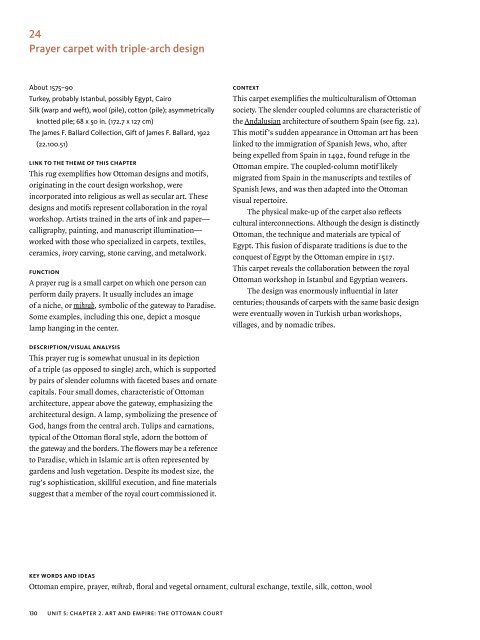Courtly Splendor in the Islamic World - The Metropolitan Museum of ...
Courtly Splendor in the Islamic World - The Metropolitan Museum of ...
Courtly Splendor in the Islamic World - The Metropolitan Museum of ...
You also want an ePaper? Increase the reach of your titles
YUMPU automatically turns print PDFs into web optimized ePapers that Google loves.
24<br />
prayer carpet with triple-arch design<br />
About 1575–90<br />
Turkey, probably Istanbul, possibly Egypt, Cairo<br />
Silk (warp and weft), wool (pile), cotton (pile); asymmetrically<br />
knotted pile; 68 x 50 <strong>in</strong>. (172.7 x 127 cm)<br />
<strong>The</strong> James F. Ballard Collection, Gift <strong>of</strong> James F. Ballard, 1922<br />
(22.100.51)<br />
LInK to <strong>the</strong> <strong>the</strong>me <strong>of</strong> thIs Chapter<br />
This rug exemplifies how Ottoman designs and motifs,<br />
orig<strong>in</strong>at<strong>in</strong>g <strong>in</strong> <strong>the</strong> court design workshop, were<br />
<strong>in</strong>corporated <strong>in</strong>to religious as well as secular art. <strong>The</strong>se<br />
designs and motifs represent collaboration <strong>in</strong> <strong>the</strong> royal<br />
workshop. Artists tra<strong>in</strong>ed <strong>in</strong> <strong>the</strong> arts <strong>of</strong> <strong>in</strong>k and paper—<br />
calligraphy, pa<strong>in</strong>t<strong>in</strong>g, and manuscript illum<strong>in</strong>ation—<br />
worked with those who specialized <strong>in</strong> carpets, textiles,<br />
ceramics, ivory carv<strong>in</strong>g, stone carv<strong>in</strong>g, and metalwork.<br />
funCtIon<br />
A prayer rug is a small carpet on which one person can<br />
perform daily prayers. It usually <strong>in</strong>cludes an image<br />
<strong>of</strong> a niche, or mihrab, symbolic <strong>of</strong> <strong>the</strong> gateway to Paradise.<br />
Some examples, <strong>in</strong>clud<strong>in</strong>g this one, depict a mosque<br />
lamp hang<strong>in</strong>g <strong>in</strong> <strong>the</strong> center.<br />
desCrIptIon/VIsuaL anaLysIs<br />
This prayer rug is somewhat unusual <strong>in</strong> its depiction<br />
<strong>of</strong> a triple (as opposed to s<strong>in</strong>gle) arch, which is supported<br />
by pairs <strong>of</strong> slender columns with faceted bases and ornate<br />
capitals. Four small domes, characteristic <strong>of</strong> Ottoman<br />
architecture, appear above <strong>the</strong> gateway, emphasiz<strong>in</strong>g <strong>the</strong><br />
architectural design. A lamp, symboliz<strong>in</strong>g <strong>the</strong> presence <strong>of</strong><br />
God, hangs from <strong>the</strong> central arch. Tulips and carnations,<br />
typical <strong>of</strong> <strong>the</strong> Ottoman floral style, adorn <strong>the</strong> bottom <strong>of</strong><br />
<strong>the</strong> gateway and <strong>the</strong> borders. <strong>The</strong> flowers may be a reference<br />
to Paradise, which <strong>in</strong> <strong>Islamic</strong> art is <strong>of</strong>ten represented by<br />
gardens and lush vegetation. Despite its modest size, <strong>the</strong><br />
rug’s sophistication, skillful execution, and f<strong>in</strong>e materials<br />
suggest that a member <strong>of</strong> <strong>the</strong> royal court commissioned it.<br />
Key Words and Ideas<br />
Ottoman empire, prayer, mihrab, floral and vegetal ornament, cultural exchange, textile, silk, cotton, wool<br />
130<br />
unit 5: chapter 2. art and empire: <strong>the</strong> ottoman court<br />
Context<br />
This carpet exemplifies <strong>the</strong> multiculturalism <strong>of</strong> Ottoman<br />
society. <strong>The</strong> slender coupled columns are characteristic <strong>of</strong><br />
<strong>the</strong> Andalusian architecture <strong>of</strong> sou<strong>the</strong>rn Spa<strong>in</strong> (see fig. 22).<br />
This motif ’s sudden appearance <strong>in</strong> Ottoman art has been<br />
l<strong>in</strong>ked to <strong>the</strong> immigration <strong>of</strong> Spanish Jews, who, after<br />
be<strong>in</strong>g expelled from Spa<strong>in</strong> <strong>in</strong> 1492, found refuge <strong>in</strong> <strong>the</strong><br />
Ottoman empire. <strong>The</strong> coupled-column motif likely<br />
migrated from Spa<strong>in</strong> <strong>in</strong> <strong>the</strong> manuscripts and textiles <strong>of</strong><br />
Spanish Jews, and was <strong>the</strong>n adapted <strong>in</strong>to <strong>the</strong> Ottoman<br />
visual repertoire.<br />
<strong>The</strong> physical make-up <strong>of</strong> <strong>the</strong> carpet also reflects<br />
cultural <strong>in</strong>terconnections. Although <strong>the</strong> design is dist<strong>in</strong>ctly<br />
Ottoman, <strong>the</strong> technique and materials are typical <strong>of</strong><br />
Egypt. This fusion <strong>of</strong> disparate traditions is due to <strong>the</strong><br />
conquest <strong>of</strong> Egypt by <strong>the</strong> Ottoman empire <strong>in</strong> 1517.<br />
This carpet reveals <strong>the</strong> collaboration between <strong>the</strong> royal<br />
Ottoman workshop <strong>in</strong> Istanbul and Egyptian weavers.<br />
<strong>The</strong> design was enormously <strong>in</strong>fluential <strong>in</strong> later<br />
centuries; thousands <strong>of</strong> carpets with <strong>the</strong> same basic design<br />
were eventually woven <strong>in</strong> Turkish urban workshops,<br />
villages, and by nomadic tribes.

















